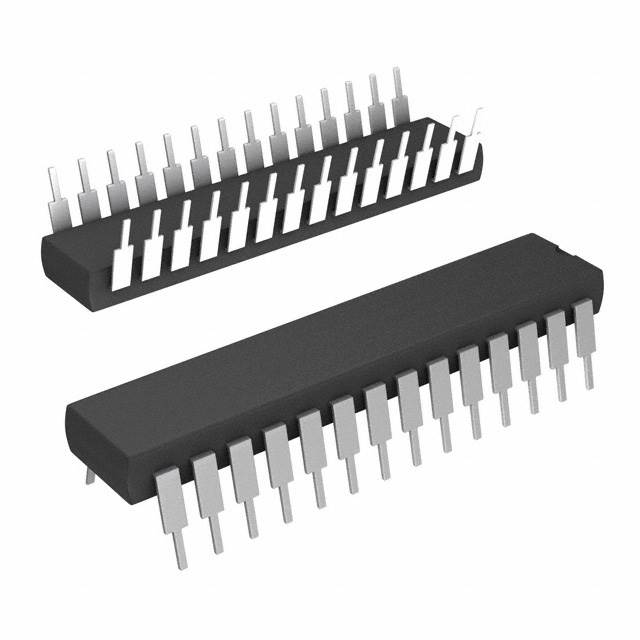PIC16LF1902-I/SP
Product Overview
Category
The PIC16LF1902-I/SP belongs to the category of microcontrollers.
Use
This microcontroller is commonly used in various electronic devices and systems for control and processing tasks.
Characteristics
- Low power consumption
- High performance
- Small form factor
- Wide operating voltage range
Package
The PIC16LF1902-I/SP is available in a 28-pin plastic dual inline package (DIP).
Essence
The essence of this microcontroller lies in its ability to provide efficient control and processing capabilities in a compact and low-power package.
Packaging/Quantity
The PIC16LF1902-I/SP is typically packaged in reels or tubes, with a quantity of 25 units per reel/tube.
Specifications
- Architecture: 8-bit
- CPU Speed: Up to 32 MHz
- Program Memory Size: 14 KB
- RAM Size: 512 bytes
- Number of I/O Pins: 25
- ADC Channels: 10-bit, 5 channels
- Communication Interfaces: UART, SPI, I2C
- Operating Voltage Range: 1.8V to 5.5V
- Temperature Range: -40°C to +125°C
Detailed Pin Configuration
The PIC16LF1902-I/SP has a total of 28 pins, each serving a specific purpose. The pin configuration is as follows:
- VDD - Power supply voltage
- RA0 - General-purpose I/O pin
- RA1 - General-purpose I/O pin
- RA2 - General-purpose I/O pin
- RA3 - General-purpose I/O pin
- RA4 - General-purpose I/O pin
- RA5 - General-purpose I/O pin
- MCLR - Master Clear input
- VSS - Ground
- RB0 - General-purpose I/O pin
- RB1 - General-purpose I/O pin
- RB2 - General-purpose I/O pin
- RB3 - General-purpose I/O pin
- RB4 - General-purpose I/O pin
- RB5 - General-purpose I/O pin
- RB6 - General-purpose I/O pin
- RB7 - General-purpose I/O pin
- VDD - Power supply voltage
- RC0 - General-purpose I/O pin
- RC1 - General-purpose I/O pin
- RC2 - General-purpose I/O pin
- RC3 - General-purpose I/O pin
- RC4 - General-purpose I/O pin
- RC5 - General-purpose I/O pin
- RC6 - General-purpose I/O pin
- RC7 - General-purpose I/O pin
- OSC1/CLKIN - Oscillator input
- OSC2/CLKOUT - Oscillator output
Functional Features
- Enhanced Mid-range Core with 49 Instruction, 16 Stack Levels
- Direct, Indirect and Relative Addressing Modes
- Flash Program Memory with Self-read/write Capability
- Power-on Reset (POR)
- Brown-out Reset (BOR)
- Low Voltage Detection (LVD)
- Programmable Code Protection
- In-Circuit Serial Programming™ (ICSP™) via Two Pins
- Watchdog Timer (WDT) with Separate On-chip Oscillator
- Analog-to-Digital Converter (ADC)
- Timers/Counters
- Capture/Compare/PWM (CCP) Modules
- Enhanced Universal Synchronous Asynchronous Receiver Transmitter (EUSART)
- Master Synchronous Serial Port (MSSP) with SPI and I2C
Advantages and Disadvantages
Advantages
- Low power consumption enables energy-efficient designs.
- High-performance capabilities allow for efficient processing of tasks.
- Small form factor makes it suitable for compact devices.
- Wide operating voltage range provides flexibility in various applications.
Disadvantages
- Limited program memory size may restrict the complexity of applications.
- Limited RAM size may impose constraints on data storage and manipulation.
Working Principles
The PIC16LF1902-I/SP operates based on an 8-bit architecture. It executes instructions stored in its program memory, utilizing various peripherals and modules to perform specific tasks. The microcontroller communicates with external devices through its I/O pins and interfaces, enabling control and data exchange.
Detailed Application Field Plans
The PIC16LF1902-I/SP finds applications in a wide range of fields, including but not limited to: - Home automation systems - Industrial control systems - Automotive electronics - Medical devices - Consumer electronics
Detailed and Complete Alternative Models
Some alternative models that offer similar functionality to the PIC16LF1902-I/SP include: - PIC16LF1903-I/SP - PIC16LF
Lista 10 Vanliga frågor och svar relaterade till tillämpningen av PIC16LF1902-I/SP i tekniska lösningar
What is the operating voltage range of PIC16LF1902-I/SP?
- The operating voltage range of PIC16LF1902-I/SP is 1.8V to 5.5V.Can PIC16LF1902-I/SP be used for battery-powered applications?
- Yes, PIC16LF1902-I/SP is suitable for battery-powered applications due to its low power consumption.What are the key features of PIC16LF1902-I/SP?
- Some key features of PIC16LF1902-I/SP include nanoWatt XLP technology, multiple communication interfaces, and a wide operating voltage range.Is PIC16LF1902-I/SP suitable for IoT applications?
- Yes, PIC16LF1902-I/SP is suitable for IoT applications due to its low power consumption and communication interfaces.Can PIC16LF1902-I/SP be programmed using C language?
- Yes, PIC16LF1902-I/SP can be programmed using C language with the MPLAB XC8 compiler.What is the maximum clock frequency supported by PIC16LF1902-I/SP?
- The maximum clock frequency supported by PIC16LF1902-I/SP is 32 MHz.Does PIC16LF1902-I/SP have analog-to-digital conversion (ADC) capability?
- Yes, PIC16LF1902-I/SP has integrated ADC modules for analog signal processing.Can PIC16LF1902-I/SP be used in automotive applications?
- Yes, PIC16LF1902-I/SP is suitable for automotive applications due to its wide operating voltage range and robust design.What development tools are available for programming PIC16LF1902-I/SP?
- Development tools such as MPLAB X IDE and PICkit programmers are available for programming PIC16LF1902-I/SP.Is PIC16LF1902-I/SP RoHS compliant?
- Yes, PIC16LF1902-I/SP is RoHS compliant, making it suitable for environmentally conscious designs.


